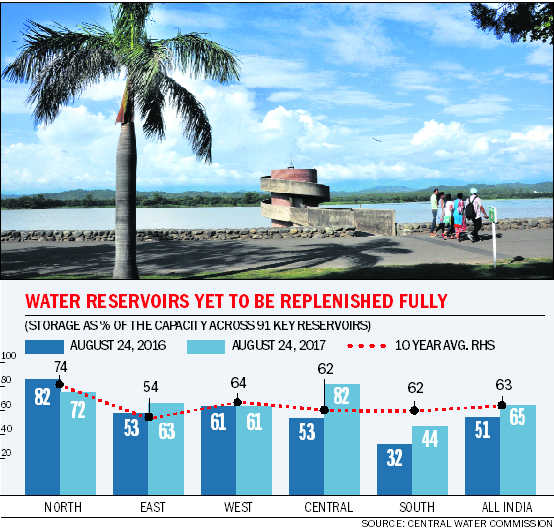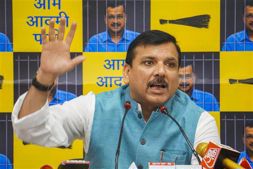
SK Saluja
Sukhna is a man-made lake fed by rain water, but increasing climatic variability, extreme weather events and rising temperatures are posing new challenges for the availability of rain water in the region.
Experts predict that temperature in India is likely to rise by more than 3°C by the end of the 21st century. This will further worsen the situation due to unpredictable rains and higher evaporation losses. In future, changes in the timing and uneven distribution of rain will further make the inflows more uncertain at Sukhna Lake. The box below shows the position of reservoir filling in India published by the Central water Commission, New Delhi. It reflects the declining trend of water storage during the years 2016 and 2017. Similar is the situation of reservoirs of 12 low dams falling in kandi area in Punjab region. The position of Sukhna is no different from low dams in Kandi area.
One main reason for the low water level in Sukhna is its reduced capacity due to heavy siltation. This has in fact increased the surface area of the lake as the same water with lesser available depth is spreading over a larger area. This has worsened the problem as evaporation losses are directly proportional to the surface area.
In fact, Sukhna Lake has outlived its life. The life of a lake/dam is related to the reduction in the capacity of the lake due to siltation. As per engineering norms, the life of a lake for small dams is taken at 40 to 50 years. Since Sukhna Lake was constructed in 1958, in terms of engineering terminology, it has already outlived its life. So, the problem being faced by the Chandigarh Administration is an engineering phenomena. The solution lies in taking initiatives to rebuild the lake involving higher finance than that required for regular upkeep and maintenance.
The present steps being taken by the Chandigarh Administration as per the directions of the Punjab and Haryana High Court will help only to some extent as these are not sustainable and permanent solutions. We have to think ahead.
The issue has to be tackled from the engineering point of view, based on “nature-based solution” rather than being fully dependent on artificial man-made arrangements like filling the lake with tertiary water and building check dams etc.
The World Water Development Report 2018 recently published in March this year also suggested that “nature-based solution for water” was needed to manage water resources to offset the challenges from climate change and population growth.
The serious concerns involved are evaporation losses, siltation, seepage and reduced inflow. Not much can be done for the reduced inflow except resorting for making arrangements such as artificial feeding of the lake and taking measures in the catchment area. For other concerns, we have to take up two major tasks.
First is to desilt the bed to its designed bed level. Secondly, to tackle evaporation and seepages losses and offset the problem of less and uncertain inflows due to changed climatic conditions. For this, we may create a twin reservoir system in Sukhna Lake with gated structure at the centre or at other convenient locations to regulate the flow from the supplementary reservoir to the main reservoir.
At the controlling structure, a weir with raised crest and gated structure should be constructed. Both reservoirs should be deepened from the existing bed and the bed of main reservoir shall be at least 5-6 feet deeper than the supplementary reservoir, so that sufficient depth is available in the main reservoir when summer is at its peak. For aquatic habitats, we can provide a fish ladder in the controlling structure.
The purpose of twin reservoir is to create more depth within the confined lake area with proper desilting arrangements. During the rainy season, water will first enter into the supplementary reservoir instead of falling freely with heavily laden silt in the open lake. Once the supplementary reservoir is filled up to crest level, then comparatively silt-free water from the top layer shall start flowing over the crest into the main reservoir. But the flow can be controlled through the gates as per the situation, so that silt transfer to the main reservoir is minimised. The silt-free water can be transferred during the rainy season and once the rains are over, the flexibility of transferring the whole water from the supplementary reservoir into the main reservoir as per the situation will be there.
Siphoning or pumping arrangement can also be provided so that it will be possible to transfer water from the supplementary reservoir to the main reservoir.
Once the supplementary reservoir is emptied, de-silting can be done on yearly basis or every alternate year as per the quantum of silt deposit in the supplementary reservoir, without affecting water storage in the main reservoir.
The bund separating the reservoirs can be utilised for landscaping. To reduce seepage losses, waterproofing membrane can be provided in the bed of the main reservoir. Alternatively, an artificial reservoir can also be constructed near the confluence point and the redundant part of the lake can be levelled as the supplementary reservoir increases seepage losses.
Comparatively clear water can be brought from the artificial reservoir constructed near the confluence point to the lake through a lined channel. The number of check dams already constructed upstream can be reduced to help increase it the flow during the rains.
(The writer is Secretary, RSDC Board, Water Resources Bhawan)



























